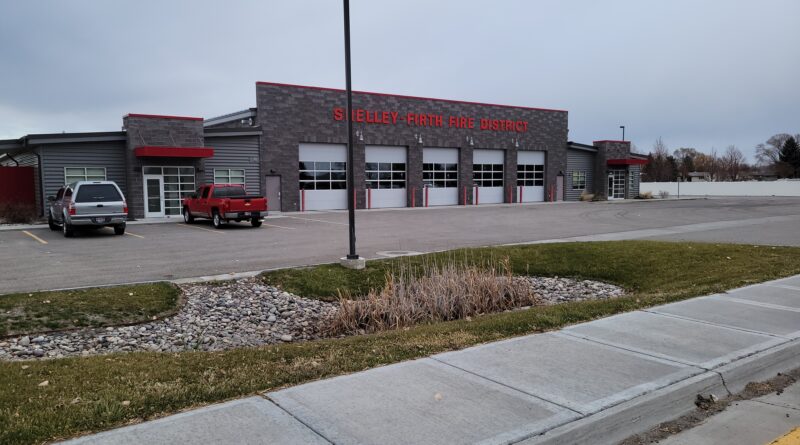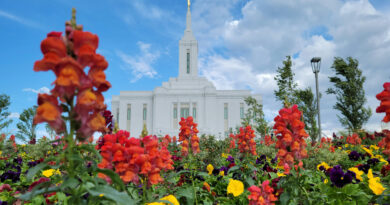Shelley-Firth Rural Fire District & QRU prepare for new residential growth
SHELLEY – The Shelley-Firth Rural Fire District and Quick Response Unit plan to meet the explosion of new housing development across northern Bingham County despite budget restraints levied against them by new State legislation.
The Shelley QRU responded to 726 calls this past year, up approximately 100 calls from three years ago; the Shelley-Firth Rural Fire District responded to 300 calls, up from 111 calls in 2017, according to Idaho State Fire Marshall’s 2017 and 2020 Annual Reports. At the same time, the two entities’ budgets only increased 3 percent per year, according to Fire District Chief Randy Adams.
“The increase calls are due to a population increase in the area,” EMS Chief Lyle Barney said. “Many of the calls were due to traffic accidents.”
According to State Marshal’s Annual Reports, the population within the Shelley-Firth Fire District grew 2,000 people from 2017 to 2020.
“This new growth will cover new fire equipment and personnel,” Adams said. “But I worry about the new house bill that will limit our ability to receive increased funding from such growth.”
House Bill 389 hurts district budgeting.
At the end of this year’s legislative session, the house and senate rushed through House Bill 389 as an attempt at tax reform. The bill limits new values on the tax rolls to 90 percent of the value of new construction and annexed properties and 80 percent of the value of properties in expiring urban renewal districts. Usually, the fire district has included such development in their budget calculations at 100 percent of improved value, generating a tax revenue necessary to cover their increased services. Read House Bill 389
The bill also limits the expansion of the district budget by imposing an absolute 8 percent cap on budget and property tax increases. The bill allows a district to grow beyond 8 percent, but only through an election with 66.6 percent voter approval. Typically, a super-majority vote is only required for a district seeking to take on additional debt but not increase its operating expenses.
“I am concerned we can’t meet the type of growth occurring in our area with this type of legislation,” Adam said.
QRU Budget Concerns
Property tax funds both the Fire District and the QRU. The fire district’s funds are from taxes levied against properties within the district itself. The QRU’s funding is from taxes imposed against properties county-wide through a county ambulance district maintained by the county commissioners.
The QRU receives 20.5 percent of that district’s total tax, while Blackfoot takes 65.4 percent, and Aberdeen takes 14.10 percent. The county commissioners determine the distribution rate for each entity.
In 2021, the county’s ambulance district levied $1,020,653, of which the QRU received only $209,233 for its annual budget, according to the Bingham County Clerk’s Office. However, these funds do not cover most of the costs incurred by the QRU operation.
“Most of the operational costs for the QRU are covered by grants, fundraisers, and a huge amount of volunteerism,” Fire District and QRU Secretary and Treasurer Brandon Jolley said. “The fire district allows the QRU to use the fire station in Shelley for free. Members of the district provide free repairs on the medical vehicles. This last year, covid monies helped out a lot.”
Everyone involved agrees that if the QRU is to provide adequate service to all of the new and anticipated growth in the area, its funding structure must change.
“Either the county needs to seek an increase in taxes for the county’s ambulance district, or the Shelley-Firth Rural Fire District needs to increase its taxes so it can incorporate the QRU into its operation and service,” Jolley said.
QRU looking to transport patients
Another significant upcoming issue for the QRU is transportation. Currently, the QRU provides first response aid but does not transport an individual to a hospital. A patient is transported either by the Idaho Falls or Blackfoot paramedics.
“800 North is the dividing line whether you are transported by Idaho Falls or Blackfoot paramedics,” Barney said. “We respond to calls from 350 North to the Bonneville County Line and on the interstate from the Rose Exit 98 to mile-marker 112.5. We cover 528 square miles.”
Idaho Falls and Blackfoot each charge the QRU a little over $100,000 per year for transporting patients. Based on the number of transports, the cost per patient going to Idaho Falls is approximately $145, while going to Blackfoot is roughly $850. This expense takes up most of the QRU’s current funding from the county.
The QRU is working on acquiring the equipment to transport its patients. However, they do not have the funds to purchase one let alone two ambulances, which would be required.
“Transporting patients requires personnel who are BLS (Basic life support) trained,” Barney said. “We have personnel now who are BLS trained.”
According to Barney, the cost to acquire one ambulance is roughly $150,000 to $200,000 per unit. Once they are purchased, the QRU will no longer need Blackfoot or Idaho Falls services. The cost of operating the units will come directly from billing patients’ insurance companies.
“Because of increased growth in the area, both Idaho Falls and Blackfoot have told us they will likely not be able to continue to provide transportation long-term with the QRU,” Barney said.
Growth presents more than budget problems
Increased residential growth in the area also presents a logistical problem for the fire district when fighting a brush or structure fire. Many new rural subdivision homes have individual domestic wells but no community well.
“If a structure fire occurs within a rural development, we have limited water to fight it unless there is a canal nearby full of water,” Adams said. “Otherwise, it is a trip back to Shelley or one of a few rural developments that have a fire hydrant with sufficient water pressure to fill up the tanker truck.”
According to Adams, a fire district’s pumper truck carries 1,000 gallons of water. The district’s only tanker truck carries 5,000 gallons. Two hoses or the pumper truck’s fire nozzle can drain the tanks within 10 minutes or less during a structure fire.
“I need ingress and water to fight a fire in a rural development,” Adam said. “Without them, multiple homes and structures are at risk.





